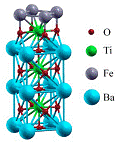Department of Physics and Astronomy: Publications and Other Research

Evgeny Tsymbal Publications
ORCID IDs
Ryu https://orcid.org/0000-0002-9617-4958
Paudel https://orcid.org/0000-0002-9952-9435
Bark https://orcid.org/0000-0002-9394-4240
Fong https://orcid.org/0000-0001-5930-8243
Eom https://orcid.org/0000-0002-8854-1439
Document Type
Article
Date of this Version
2022
Citation
APL Materials (March 2022) 10(3): 031115
doi: 10.1063/5.0067445
Supplementary materials are available at https://www.scitation.org/doi/suppl/10.1063/5.0067445
Abstract
Atomically flat (111) interfaces between insulating perovskite oxides provide a landscape for new electronic phenomena. For example, the graphene-like coordination between interfacial metallic ion layer pairs can lead to topologically protected states [Xiao et al., Nat. Commun. 2, 596 (2011) and A. Rüegg and G. A. Fiete, Phys. Rev. B 84, 201103 (2011)]. The metallic ion/metal oxide bilayers that comprise the unit cell of the perovskite (111) heterostructures require the interface to be polar, generating an intrinsic polar discontinuity [Chakhalian et al., Nat. Mater. 11, 92 (2012)]. Here, we investigate epitaxial heterostructures of (111)-oriented LaAlO3/SrTiO3 (LAO/STO). We find that during heterostructure growth, the LAO overlayer eliminates the structural reconstruction of the STO (111) surface with an electronic reconstruction, which determines the properties of the resulting two-dimensional conducting gas. This is confirmed by transport measurements, direct determination of the structure and atomic charge from coherent Bragg rod analysis, and theoretical calculations of electronic and structural characteristics. Interfacial behaviors of the kind discussed here may lead to new growth control parameters useful for electronic devices.


Comments
Copyright 2022, the authors. Open access
License: CC BY 4.0